Beaminster, Dorset
Up to 1834
Following an endowment from Gilbert Adams, Beaminster's first workhouse was built in 1626 at Allen's Loscombe, Powerstock. It was rebuilt in 1737, then converted to a school-room in 1836 after the new Union workhouse was inaugurated.
A parlimentary report of 1777 recorded a parish workhouse in operation at Beaminster for up to 100 inmates.
Netherbury had a parish workhouse on St James Road.
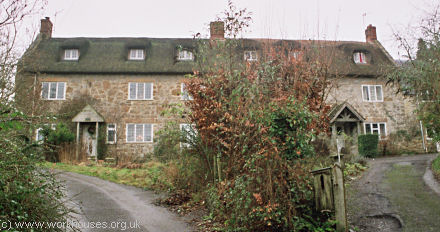
Netherbury former parish workhouse.
© Peter Higginbotham.
The appropriately named North Poorton had its own parish workhouse.
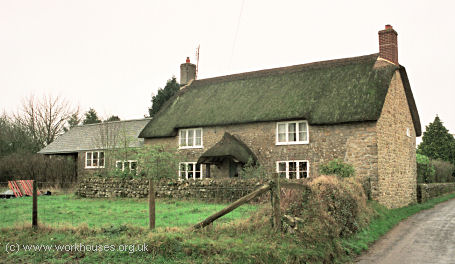
North Poorton former parish workhouse.
© Peter Higginbotham.
Marshwood presumably had a poorhouse in the vicinity of Poorhouse Lane which runs between Taphouse Farm and Charing Cross, a mile to the west of Shave Cross.
After 1834
Beaminster Poor Law Union was formed on 28th March 1836. Its operation was overseen by an elected Board of Guardians, 31 in number, representing its 26 constituent parishes as listed below (figures in brackets indicate numbers of Guardians if more than one):
Dorset:
Beaminster (3), Bettiscombe, Broadwindsor (2), Burstock, Chedington, East Chelborough, West Chelborough, Corscombe, Evershot, Halstock, Hooke, Mapperton, Marshwood, Melbury Osmond, Melbury Sampford, Mosterton, Netherbury (2), South Perrot, Pilsdon, Powerstock (2), North Poorton, Rampisham, Stoke Abbot, Wraxall.
Later Additions: Seaborough (from 1895), Thorncombe (from 1896)
Somerset:
Misterton, Seaborough.
The population falling within the union at the 1831 census had been 13,869 with parishes ranging in size from Seaborough (population 41) to Beaminster itself (2,968). The average annual poor-rate expenditure for the period 1833-36 had been £7,541.
The new Beaminster Board of Guardians met for the first time on 6th April 1836 at the Red Lion Inn. At a later meeting they resolved "that the several Workhouses within this Union, viz. Beaminster, Broadwindsor, and Netherbury, be appropriated to the use of the Union, and that the salaries of the respective governors be as follows, viz. Mr Guppy at Beaminster, at the rate of £60 per annum, Mr Hardy at Netherbury £45 per annum, Mr Day at Broadwindsor £30 per annum."
The new union workhouse was built at Stoke Water, about a mile to the south-west of the town. The two-acre site, then known as Carrot Close, was bought from Samuel Cox Esq. at a cost of £315.
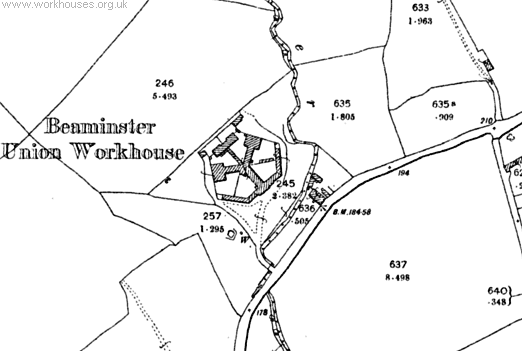
Beaminster workhouse site, 1903
The new building was designed to accommodate 230 inmates and cost around £4,500. The builder was Richard Warr and the architects were HJ Whitling and Edward Mundey. The architect's fee was 3½ percent of the building cost, which amounted to just over £157. The total cost of the new establishment was thus just over £5,000.
The workhouse design was a modified, somewhat "squashed", form of the popular hexagonal "Y" plan — somewhat resembling an anchor in appearance, as can be seen on the aerial view below.
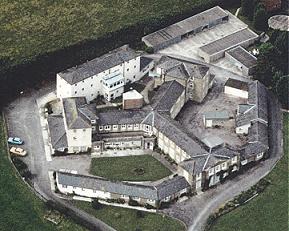
Beaminster from the south.
courtesy of Ruth Lyons.
The new workhouse was opened for occupation on 24th June, 1838 with Mr and Mrs Guppy as Master and Matron, for which they received a salary of £60 per annum "and such provisions as the house may afford." The Guardians met in their new Board Room at the workhouse five days later. Amongst their early appointments were Richard Whitty as porter at £5 per annum, John Cox as schoolmaster at £7 per annum, and Sarah Hayward as schoolmistress at £15 per annum.
The following Christmas, the Guardians ordered "that the inmates have plum pudding and I beer on Christmas Day." However, four years later, on December 26th 1843, it was recorded that "the male inmates request the Master to report their intention of petitioning for more food." In 1846, because of a shortage of potatoes caused by crop failure (this was the period of the potato famine in Ireland), rice was substituted in the diet.
In 1849, the infirmary at the north of the workhouse had wings added at a cost of £190, and had a second storey added in 1863 at a cost of £198. In 1850, a tailor's shop was built and oakum-picking was introduced. In 1852, the first infirmary nurse was appointed. Also that year, the old and infirm were allowed tea with their evening meal.
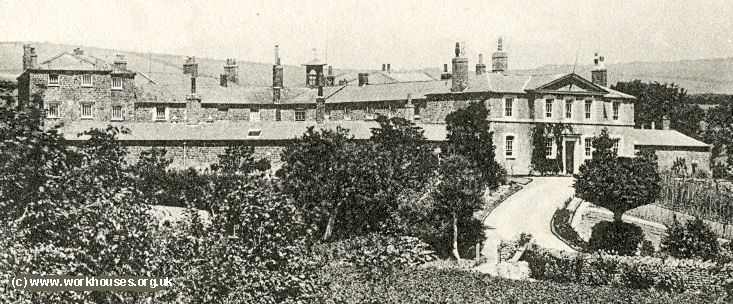
Beaminster workhouse from the south, c.1910.
© Peter Higginbotham.
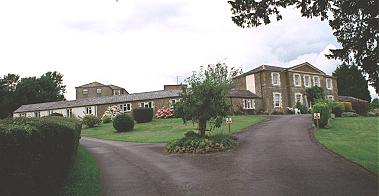
Beaminster from the south, 2000.
© Peter Higginbotham.
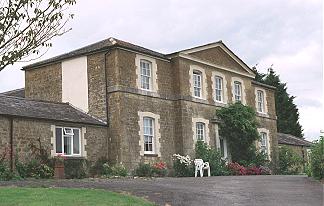
Beaminster entrance block, 2000.
© Peter Higginbotham.
A chilling insight into life in the workhouse is provided by the Pauper Offence Book which illustrates how severely misdemeanors by inmates were treated. Offences against property, such as breaking a windows, received particularly harsh punishment:
| Name | Offence | Date | Punishment |
| Elliott, Benjamin | Neglect of work | 31 May 1842 | Dinner withheld, and but bread for supper. |
| Rowe, Sarah | Noisy and swearing | 19 June 1842 | Lock'd up for 24 hours on bread and water. |
| Aplin, John | Disorderly at Prayer-time | 22 July 1842 | Lock'd up for 24 hours on bread and water. |
| Mintern, George | Fighting in school | 26 July 1842 | No cheese for one week. |
| Greenham, Mary and Payne, Priscella | Quarreling and fighting | 14 Dec 1842 | No meat 1 week. |
| Bartlett, Mary | Breaking window | 21 Mar 1843 | Sent to prison for 2 mths. |
| Park, James | Deserted, got over wall | 4 Sep 1843 | To be whipped. |
| Hallett, Isaac | Breaking window | 25 April 1844 | Sent to prison for 2 months hard labour. |
| Staple, John | Refusing to work | 7 Jany. 1856 | Committed to prison for 28 days. |
| Johnson, John | Refusing to work | 19 Oct 1858 | Cheese & tea stop'd for supper. Breakfast stop's altogether. |
| Soaper, Elizabeth | Making use of bad language in bedroom. Trying to excite other inmates to insubordination. Refusing to work. | 17 Jany. 1863 | Taken before the Magistrate & committed to prison for 14 days hard labour. |
| Note by Chairman of the Guardians: "Would not 28 days be better—J.F.?" | |||
Things were not entirely grim, however. On March 10th 1863, there was a "Dinner to Inmates to commemorate the Wedding Day of the Prince of Wales, similar to that given on Christmas Day." The following year, vagrant wards were erected to accommodate six men and four women. Each tramp was allowed 7 oz. of bread for supper, and the same for breakfast.
Between 1868 and his death in 1872, Thomas Beale held the post of schoolmaster. During this time he taught the boys to play the fife, and established the Union Fife and Drum Band which became popular with the townspeople. Occasionally, the workhouse children would process — in their workhouse uniforms — into Beaminster led by the band. The band provided the music at the Church Sunday-school summer treat at Parnham in 1869. The children also enjoyed the occasional trip to the seaside:
August 25th, 1899
DAY OUT. On Monday, the children of Beaminster Union were given a real treat. About 10 O'clock they were conveyed in a brake from Beaminster to West Bay. they were accompanied by Mrs JB Dunn, Miss Hine, Mrs Andrews the Matron, and Miss Bevan the industrial trainer, who did all they could to see the little folks had a happy day. Between meals they enjoyed themselves on the beach as only children can. Mrs Dunn, who with her husband takes a keen interest in the welfare of the Union, provided a capital tea.
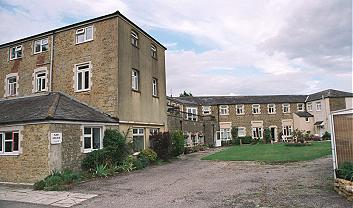
Beaminster from the west, 2000.
© Peter Higginbotham.
In 1907, two rooms in the workhouse were converted into a chapel. By 1912, when the workhouse became officially known as Beaminster Poor Law Institution, it seems to have been functioning mainly as an infirmary. Its official accommodation capacity was now reduced to 130, with room in the tramp wards for sixteen men and three women.
By 1924, the institution seems to have been suffering from staffing problems, for which it was considering a novel remedy:
November 14th, 1924
WORKHOUSE TUNES. The question of installing a wireless set at the Poor Law Institution was further considered at the meeting of Beaminster's Board of Guardians. One of the difficulties that has confronted the Guardians has been that of keeping Officers at the House because of its out of the way position. Mr Johnson stated that, as it was only an experiment, it would not be advisable to spend more than 30 guineas on a wireless set. Mr Angus said that he understood that a wireless was to be installed with a view to making the inmates happy as well as the nurses. Capt. Digby said that before it was installed it would be well to know the doctor's opinion as to how a wireless would affect the sick in the infirmary. Dr Pim thought it would cheer the inmates up.
In 1930, the workhouse became Beaminster Public Assistance Institution. During the Second World War, it was taken over for use as military accommodation. Afterwards it became Stoke Water House, an elderly persons' home, until being converted into flats in 1974.
Staff
Inmates
Records
Note: many repositories impose a closure period of up to 100 years for records identifying individuals. Before travelling a long distance, always check that the records you want to consult will be available.
- Dorset History Centre, Bridport Road, Dorchester DT1 1RP. Holdings include: Guardians' minute books (1836-1930); Pauper Offence Book 1842-69; etc.
Bibliography
- A History of Beaminster by Marie Eedle (Phillimore, 1984)
- History of Beaminster by Richard Hine (1912)
- A History of Dorset by J Hutchins (1774)
Links
- None.
Acknowledgment
- Thanks to Ruth Lyons and Chris Etherington for help in compiling this page.
Unless otherwise indicated, this page () is copyright Peter Higginbotham. Contents may not be reproduced without permission.


